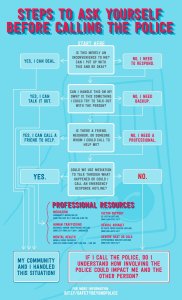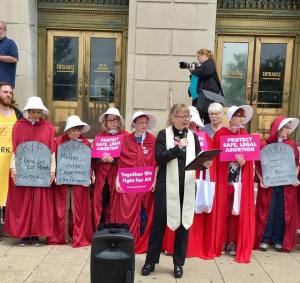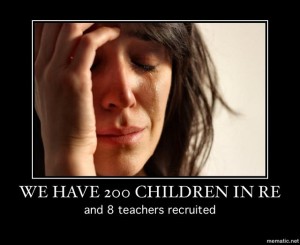This is for my White friends and acquaintances who I still see talking about #JesusChristSuperstarLive but who aren’t talking about the role race played in the show.
I don’t normally watch the “Live TV” events that occasionally happen because I find them pretty awkward, but I will confess I was excited about NBC’s Jesus Christ Superstar. It is a musical that I love and the cast looked fantastic. I figured we would give it a try.
The opening was amazing, but when Mary (played exquisitely by Sara Bareilles) began her iconic Everything’s Alrightmy focus shifted and I realized that I wasn’t just watching a new staging of an award-winning musical; I was watching a commentary on black/white relations in the United States: Mary, a White woman, was pleading with Judas and Jesus (played by two Black men who knew things were escalating towards disaster) to calm down and not take things so seriously. “Try not to get worried, try not to turn on to problems that upset you, oh. Don’t you know, everything’s alright, yes, everything’s fine.”
White friends – Did you notice this? Did you notice that it was a White woman who was telling these Black men to calm down. How often do we White people get uncomfortable at Black rage? How often do wetone police? And here it was, starkly presented, right here before 9.4 million viewers, most of whom were probably white.
We’ve seen before how flipping the racial narrative on a cast can give new understanding to an old story. Hamilton, anyone? If we want to become allies, the first steps are to educate ourselves and to pay attention. #JesusChristSuperstarLive can give us a lens into our own commitment level to confronting racism and white supremacy, especially in the context of systemic oppression via police brutality, militarism and the prison/torture industrial complex. Here are eight other ways that I caught (and I know I didn’t catch it all) that race played an essential role in the production:
1) Having a Black Jesus. I don’t know about how other white people grew up, but Jesus was never ever black in the traditions of my experience. At best, and I mean at very best, he was a bit brown. But even that was unusual.White people seem to get upset when Jesus is portrayed as anything other than White. I would link to site after site trying to argue that fact, but I don’t want to push traffic that way. Look it up yourselves: many White people can’t handle that Jesus was not White. But he wasn’t. Having a Black Jesus is an important corrective to the dominant narrative. Especially as we will see below. Seeing someone who looks like you on tv, in books, in advertising, in the toys children play with – this sort of representation is crucially important. We know this. From the chatter I’ve seen on facebook from Black friends, having a Black Jesus was absolutely a game-changer.
2) Having a Black Judas. Now, Judas has been portrayed as black before. In fact, Judas (played by Carl Anderson) was one of only a few black characters in the 1973 movie Jesus Christ Superstar. What was new here in #JesusChristSuperstarLive was the dynamic between a Black Judas and a Black Jesus. In the song Heaven on Their Minds, Judas sings “Listen, Jesus, do you care for your race? Don’t you see we must keep in our place? We are occupied! Have you forgotten how put down we are?” These lyrics take on a totally different meaning when Judas is singing to another Black man. We are reminded of the distinction Chris Hayes introduced many of us to in his book A Colony in a Nation, which highlights many of the ways that Black communities and Black men in particular are treated as if they were unruly colonists who must be controlled and managed by those in power.
 (The fact that the part of Judas was played by Brandon Victor Dixon, who gave the Hamilton cast speech when VP Mike Pence attended & who did a Wakanda salute at the end, just added to the awesomeness.)
(The fact that the part of Judas was played by Brandon Victor Dixon, who gave the Hamilton cast speech when VP Mike Pence attended & who did a Wakanda salute at the end, just added to the awesomeness.)
3) Notice how both Herod and Pilate are White. The men making the decisions, the men with the power, are White. Just like 7 in 10 senior executives and just like the vast majority of our elected national representatives in the House and Senate. Yeah, Pilate may be tortured about his decision, but he also caved under pressure. How many of us white people have done something similar? Maybe we have cringed silently and not spoken up when we we were in a situation with a work colleague spouting racist ideas. Maybe we strive towards being colorblind and don’t even realize how we are unwittingly contributing to racism.
4) So now you might be saying, “But Caiaphas was black!” And that is true -Norm Lewis was amazing in the role. But Caiaphas, as a Pharisee, didn’t have the power to have Jesus arrested on his own, did he? He just made the recommendation to Pilate (a White guy), who had the actual power. Having the Pharisees all be people of color invoked classic Uncle Tom imagery of a Black man who sells out his race in order to get a little power – just like the slave drivers who would beat their own for whatever scraps the white slave master would throw his way. Dynamics of divide and conquer and starvation economics where there isn’t enough power so we grab what we can are both at work in this dynamic. I’m reading Trevor Noah’s book Born a Crime: Stories from a South African Childhood right now and the passages on the creation of apartheid are stunning to me in that this was a system that was intentionally created to turn the black Africans against one another by giving different groups different sets of rights. How else do you control a population 4 times as large as your own? It is a stunningly effective strategy for mass oppression.
5) Let’s go to Mary again. This time, singing I Don’t Know How to Love Him when she asks in the chorus “Should I bring him down, should I scream and shout? Should I speak of love, let my feelings out?” – How many of us White people are in that situation? We are trying to be allies, but we don’t really know what to do. Do we join the with the anger? Do we fight back with love? What does it really mean to be a White ally to Black people in the United States in 2018? It can get complicated and confusing. But unfortunately, our confusion and our fear of making a mistake often leads us to wring our hands and offer vague comfort from afar.

Steps to Ask Yourself Before Calling the Police
6) When the police show up in Gethsemane, Judas kisses Jesus and they embrace, and the police try to pull Jesus away. Judas has suddenly realized how this is not going the way he expected, and he holds on to Jesus and tries to pull him away from the police. Judas learned the hard way: if you call the police on a Black man, prepare for it escalating. White people, in particular but not exclusively, who think the police are benevolent forces of law and order often have a difficult time realizing that a call to the police about something innocuous like vandalism might result in the murder of an innocent Black man with a cell-phone in his backyard. In case you are wondering, there are some excellent online resources for trying to determine whether you should call the police.
7) After Jesus is taken away and Peter has betrayed him, Mary comes to comfort Peter – to offer him forgiveness. Both of them are non-black. While they are both rightfully upset, they turn and walk away. They have the privilege to be able to sit with each other, comforting one another, while Judas and Jesus are both tortured (Judas internally) and die. How often do we, as White allies, return to our bubbles to lick our wounds? What would it be like if Mary and Peter had gone to Judas and included him in their circle of grief? Instead, far too often, we retreat instead of laying our lives down on the line for the beloved community that we crave. What would it look like if we didn’t let each other off the hook quite so easily?
8) This last one is about what you didn’t see rather than what you did. Rather than invoke the imagery of a slave receiving a whipping by having Black Jesus flogged, the creative choice was made (brilliantly, in my opinion) to instead have different members of the community beat Jesus. Yes, it showed up as whip-marks on his back, but in this case, it is Jesus’s own extended community that turned on him. How often and in how many ways do we turn on the Black men in our community? Eric Garner shouldn’t have been selling cigarettes. Tamir Rice shouldn’t have been playing with a toy gun. Stephon Clark shouldn’t have..what? Been in his grandmother’s backyard with a cell phone? We blame the Black victim – sometimes because we are trying to make sense of a situation that makes no reasonable sense and other times to try to protect ourselves from a world of violence that feels out of our control. But the system is doing exactly what it was designed to do. As White people, we have power and we need to use it to end systems of oppression like our prison industrial system, policing system, and work for solutions like felon voting rights. Can you imagine what our country might look like if 2.3 million Black men weren’t incarcerated? If 1 in 8 of them weren’t disenfranchised from voting?
So there you have it. Here are just 9 (including the first Mary example) creative decisions, brilliantly made, that expose a mainstream audience to the epidemic of violence against Black men. And I know I missed quite a few.
I had no idea when turning it on that this new production of Jesus Christ Superstar would be an allegory for what it means to be a Black man in the United States in 2018. #JesusChristSuperstarLive used an old story to offer a new challenge to those of us who wish to be White allies: Pay attention, and then go educate ourselves on how systemic racism and white supremacy culture are alive in the United States today, so that we might be a part of the solution.
Tags: Easter, Racial Justice





 As I passed through security, something unique happened. An older man looked at me, smiled, and asked what denomination I was with. For a year now,
As I passed through security, something unique happened. An older man looked at me, smiled, and asked what denomination I was with. For a year now,  Here is what I think is going on: people still don’t know what to do with a female cleric. It makes them confused from the get-go. And if they happen to look at me long enough to see the pins, they get knocked off-balance. I should make it explicit: I don’t get any negative comments about the pins. Maybe I would if it were just a rainbow flag pin, or just a Black Lives Matter pin. But the combination of the pins makes is quite clear that I am in support of those who are oppressed and marginalized in our society. Unfortunately, this is often in direct opposition to the image the clerical collar presents. Generally, I think the intersectionality of a woman in a collar wearing these pins makes most people especially confused. When I have a chance to interact with someone for more than a couple of seconds, if that person is a person of color, they almost always comment on how awesome my pins are. The only white person who ever said anything presented as gender non-conforming.
Here is what I think is going on: people still don’t know what to do with a female cleric. It makes them confused from the get-go. And if they happen to look at me long enough to see the pins, they get knocked off-balance. I should make it explicit: I don’t get any negative comments about the pins. Maybe I would if it were just a rainbow flag pin, or just a Black Lives Matter pin. But the combination of the pins makes is quite clear that I am in support of those who are oppressed and marginalized in our society. Unfortunately, this is often in direct opposition to the image the clerical collar presents. Generally, I think the intersectionality of a woman in a collar wearing these pins makes most people especially confused. When I have a chance to interact with someone for more than a couple of seconds, if that person is a person of color, they almost always comment on how awesome my pins are. The only white person who ever said anything presented as gender non-conforming.

 When my spouse recently got us tickets to one of his favorite punk bands from the 70s and 80s, we decided, rather than getting general admission tickets which would put us down on the floor, we wanted to be up on the balcony with secured seats in case we needed to give ourselves a break. It was worth the extra expenditure, but not because of the seats. Instead, I found that I spent nearly as much time watching the dancers on the floor as I did watching the band (who were amazing). And I saw something I’d never noticed before.
When my spouse recently got us tickets to one of his favorite punk bands from the 70s and 80s, we decided, rather than getting general admission tickets which would put us down on the floor, we wanted to be up on the balcony with secured seats in case we needed to give ourselves a break. It was worth the extra expenditure, but not because of the seats. Instead, I found that I spent nearly as much time watching the dancers on the floor as I did watching the band (who were amazing). And I saw something I’d never noticed before.